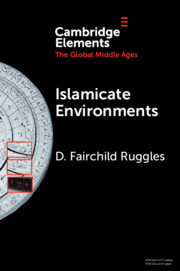Refine search
Actions for selected content:
146 results
9 - Crop and Irrigation Management from Space
-
- Book:
- Satellite Remote Sensing for Water Management
- Published online:
- 10 October 2025
- Print publication:
- 04 September 2025, pp 232-262
-
- Chapter
- Export citation
1 - Why Manage Water with Satellite Remote Sensing?
-
- Book:
- Satellite Remote Sensing for Water Management
- Published online:
- 10 October 2025
- Print publication:
- 04 September 2025, pp 1-17
-
- Chapter
- Export citation
The Scorpion Mound Complex: An Effigy Mound Site with Possible Functional/Ceremonial Significance in the Tehuacán Valley of Puebla, México
-
- Journal:
- Ancient Mesoamerica , First View
- Published online by Cambridge University Press:
- 29 August 2025, pp. 1-16
-
- Article
-
- You have access
- Open access
- HTML
- Export citation
A narrative review of social infrastructure for agricultural groundwater nature-based solutions
- Part of
-
- Journal:
- Global Sustainability / Volume 8 / 2025
- Published online by Cambridge University Press:
- 20 August 2025, e32
-
- Article
-
- You have access
- Open access
- HTML
- Export citation
Competitive ability of drought-tolerant corn hybrids in the presence of redroot pigweed (Amaranthus retroflexus) under optimal and reduced irrigation levels
-
- Journal:
- Weed Science / Volume 73 / Issue 1 / 2025
- Published online by Cambridge University Press:
- 18 August 2025, e64
-
- Article
-
- You have access
- Open access
- HTML
- Export citation
Unlocking the potential of artificial nighttime lighting in agricultural fields: a novel approach to enhancing crop productivity
-
- Journal:
- The Journal of Agricultural Science / Volume 163 / Issue 5 / October 2025
- Published online by Cambridge University Press:
- 28 July 2025, pp. 481-492
-
- Article
-
- You have access
- HTML
- Export citation
Coordination and cooperation in asymmetric commons dilemmas
-
- Journal:
- Experimental Economics / Volume 14 / Issue 4 / November 2011
- Published online by Cambridge University Press:
- 14 March 2025, pp. 547-566
-
- Article
- Export citation
Distribution of exchangeable arsenic in low-land paddy fields in Sri Lanka as affected by the agro-climatic zone, soil and water source
-
- Journal:
- The Journal of Agricultural Science / Volume 163 / Issue 2 / April 2025
- Published online by Cambridge University Press:
- 27 February 2025, pp. 192-201
-
- Article
- Export citation
Rainfall shocks and child health in rural Pakistan
-
- Journal:
- Journal of Developmental Origins of Health and Disease / Volume 16 / 2025
- Published online by Cambridge University Press:
- 14 February 2025, e9
-
- Article
-
- You have access
- Open access
- HTML
- Export citation
6 - Colonial Development in a Comparative Perspective
-
- Book:
- An Economic History of India
- Published online:
- 06 February 2025
- Print publication:
- 13 February 2025, pp 161-186
-
- Chapter
- Export citation

Islamicate Environments
- Water, Land, Plants, and Society
-
- Published online:
- 08 February 2025
- Print publication:
- 06 March 2025
-
- Element
- Export citation
Drought responses in Coffea arabica as affected by genotype and phenophase. II – photosynthesis at leaf and plant scales
-
- Journal:
- Experimental Agriculture / Volume 60 / 2024
- Published online by Cambridge University Press:
- 18 September 2024, e22
-
- Article
- Export citation
Exchangeable molybdenum concentration in lowland paddy fields of Sri Lanka as affected by the differences in agro-climatic zones, soil orders, and water sources
-
- Journal:
- Experimental Agriculture / Volume 60 / 2024
- Published online by Cambridge University Press:
- 12 September 2024, e21
-
- Article
- Export citation
6 - Technology, 1000–1500
- from Section II - The Medieval Economy, 1000–1500
-
-
- Book:
- An Economic History of the Iberian Peninsula, 700–2000
- Published online:
- 22 February 2024
- Print publication:
- 29 February 2024, pp 158-174
-
- Chapter
- Export citation
Contemporary Pedogenic Formation of Palygorskite in Irrigation-Induced, Saline-Sodic, Shrink-Swell Soils of Maharashtra, India
-
- Journal:
- Clays and Clay Minerals / Volume 56 / Issue 5 / October 2008
- Published online by Cambridge University Press:
- 01 January 2024, pp. 531-548
-
- Article
- Export citation
Loss of K-Bearing Clay Minerals in Flood-Irrigated, Rice-Growing Soils in Jiangxi Province, China
-
- Journal:
- Clays and Clay Minerals / Volume 51 / Issue 1 / February 2003
- Published online by Cambridge University Press:
- 01 January 2024, pp. 75-82
-
- Article
- Export citation
16 - Water: The Precious Resource
- from Part V - Sustainability Themes
-
- Book:
- Sustainability Science
- Published online:
- 07 December 2023
- Print publication:
- 07 December 2023, pp 396-423
-
- Chapter
- Export citation
Research and policy priorities to address drought and irrigation water resource risks in temperate agriculture
-
- Journal:
- Cambridge Prisms: Water / Volume 1 / 2023
- Published online by Cambridge University Press:
- 15 August 2023, e7
-
- Article
-
- You have access
- Open access
- HTML
- Export citation
Water footprint of representative agricultural crops on volcanic islands: the case of the Canary Islands
-
- Journal:
- Renewable Agriculture and Food Systems / Volume 38 / 2023
- Published online by Cambridge University Press:
- 04 August 2023, e36
-
- Article
-
- You have access
- Open access
- HTML
- Export citation
